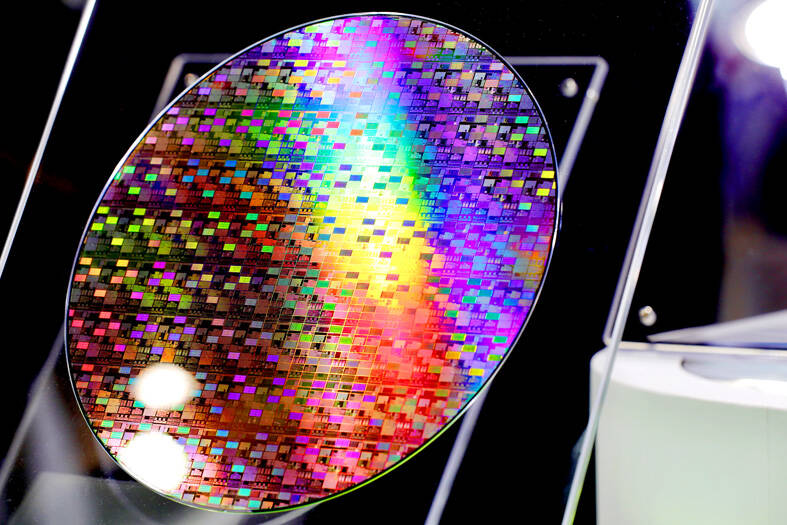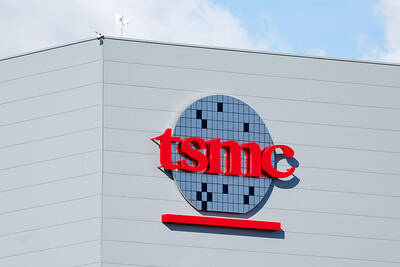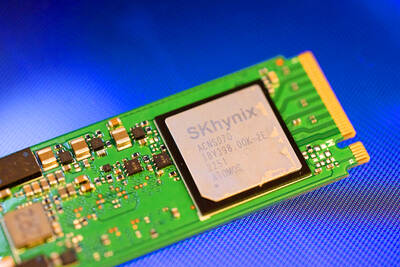Semiconductor inventory corrections should end next quarter, paving the way for a pickup in demand in the second half of this year, GlobalWafers Co (環球晶圓) said yesterday.
As a majority of its customers believe demand would bounce back in the second half, the world’s No. 3 silicon wafer maker said it is keeping most of its factories fully utilized to ensure sufficient supply.
“Our customers have committed to take those wafers. They only requested to push back shipments by a month or two,” GlobalWafers chairwoman Doris Hsu (徐秀蘭) told an investors’ teleconference.

Photo: Ritchie B. Tongo, EPA-EFE
“Overall industry inventory adjustment should be mostly resolved in the second quarter,” Hsu said. “We think the recovery will start in the second half of this year, or as late as the end of this year.”
Semiconductors used in power management applications, industrial devices and automotive devices would recover at a faster pace than those used in consumer electronics and memory chips, she said.
The company expects its revenue performance this year to be better than last year, she said.
The Hsinchu-based company reported record revenue of NT$70.29 billion (US$2.3 billion) for last year, rising 15 percent from NT$61.13 billion in 2021.
Gross margin this year should be similar to last year’s 43.2 percent, Hsu said.
The volatility of foreign-exchange rates is the crucial factor that decides the ups and downs of its gross margin, she said.
In response to investors’ concerns that Washington’s strict rules and profit-sharing scheme under the Creating Helpful Incentives to Produce Semiconductors (CHIPS) and Science Act, along with less direct funding, could make GlobalWafers’ new Texas fab an unprofitable deal, Hsu said the company is closely following the development of the regulations.
GlobalWafers expects to have a clearer picture next month or in May as the US government is to release more details in a second-round announcement about rules and measures for material suppliers such as GlobalWafers, she said.
Based on its understanding, the company is likely to receive a bigger portion of direct funding, compared with the 5 percent and 15 percent of a project’s total expenditures stipulated by the CHIPS Act, as GlobalWafers is not eligible for an investment tax credit, she said.
That direct funding range is just a general estimate, as there is no fixed amount of funding regulated yet, she said.
GlobalWafers’ Texas fab is under construction and scheduled to start mass production in the first quarter of 2025 as planned, Hsu said.
More than 80 percent of its capacity has already been reserved by customers, she said.
Regarding concerns that Tesla Inc’s plans to cut its usage of silicon carbide (SiC) semiconductors by 75 percent could undermine GlobalWafers’ financial performance, Hsu said that electric vehicles were only one of many applications for SiC.
Besides, the company is not a pure SiC supplier, but a supplier of wafers, she added.
GlobalWafers said it would stick to its SiC capacity expansion plan, given its small scale and strong forecast of a compound annual growth rate of 34 percent from last year to 2027.
GlobalWafers’ net profit expanded 29.5 percent annually last year to NT$15.37 billion, reaching a record high. Earnings per share climbed to NT$35.31 from NT$27.27 in 2021.
The company also had a record NT$39.73 billion in prepayments from customers at the end of last year, it said.
Customers signing long-term supply agreements are required to prepay, it added.

Taiwan Semiconductor Manufacturing Co (TSMC, 台積電) secured a record 70.2 percent share of the global foundry business in the second quarter, up from 67.6 percent the previous quarter, and continued widening its lead over second-placed Samsung Electronics Co, TrendForce Corp (集邦科技) said on Monday. TSMC posted US$30.24 billion in sales in the April-to-June period, up 18.5 percent from the previous quarter, driven by major smartphone customers entering their ramp-up cycle and robust demand for artificial intelligence chips, laptops and PCs, which boosted wafer shipments and average selling prices, TrendForce said in a report. Samsung’s sales also grew in the second quarter, up

LIMITED IMPACT: Investor confidence was likely sustained by its relatively small exposure to the Chinese market, as only less advanced chips are made in Nanjing Taiwan Semiconductor Manufacturing Co (TSMC, 台積電) saw its stock price close steady yesterday in a sign that the loss of the validated end user (VEU) status for its Nanjing, China, fab should have a mild impact on the world’s biggest contract chipmaker financially and technologically. Media reports about the waiver loss sent TSMC down 1.29 percent during the early trading session yesterday, but the stock soon regained strength and ended at NT$1,160, unchanged from Tuesday. Investors’ confidence in TSMC was likely built on its relatively small exposure to the Chinese market, as Chinese customers contributed about 9 percent to TSMC’s revenue last

On Tuesday, US President Donald Trump weighed in on a pressing national issue: The rebranding of a restaurant chain. Last week, Cracker Barrel, a Tennessee company whose nationwide locations lean heavily on a cozy, old-timey aesthetic — “rocking chairs on the porch, a warm fire in the hearth, peg games on the table” — announced it was updating its logo. Uncle Herschel, the man who once appeared next to the letters with a barrel, was gone. It sparked ire on the right, with Donald Trump Jr leading a charge against the rebranding: “WTF is wrong with Cracker Barrel?!” Later, Trump Sr weighed

LOOPHOLES: The move is to end a break that was aiding foreign producers without any similar benefit for US manufacturers, the US Department of Commerce said US President Donald Trump’s administration would make it harder for Samsung Electronics Co and SK Hynix Inc to ship critical equipment to their chipmaking operations in China, dealing a potential blow to the companies’ production in the world’s largest semiconductor market. The US Department of Commerce in a notice published on Friday said that it was revoking waivers for Samsung and SK Hynix to use US technologies in their Chinese operations. The companies had been operating in China under regulations that allow them to import chipmaking equipment without applying for a new license each time. The move would revise what is known